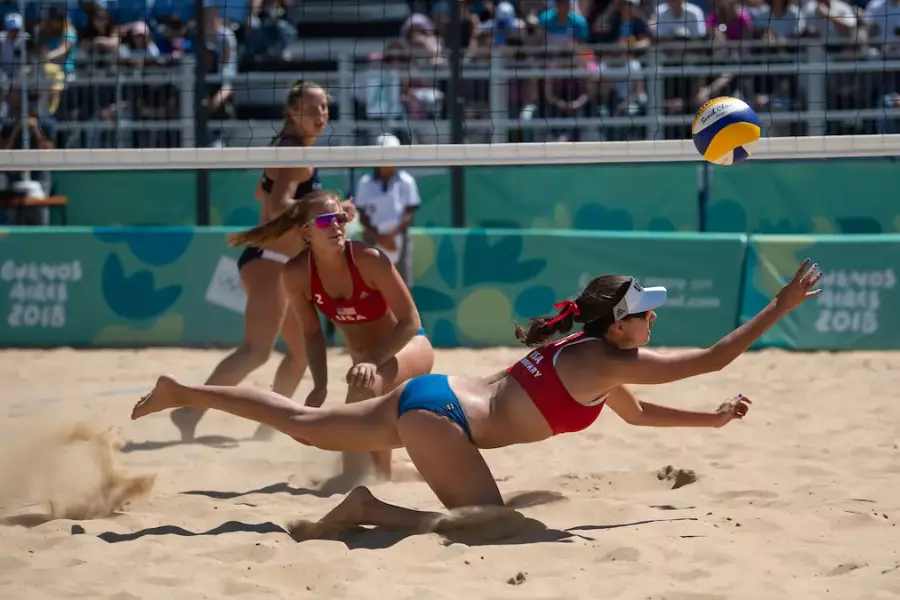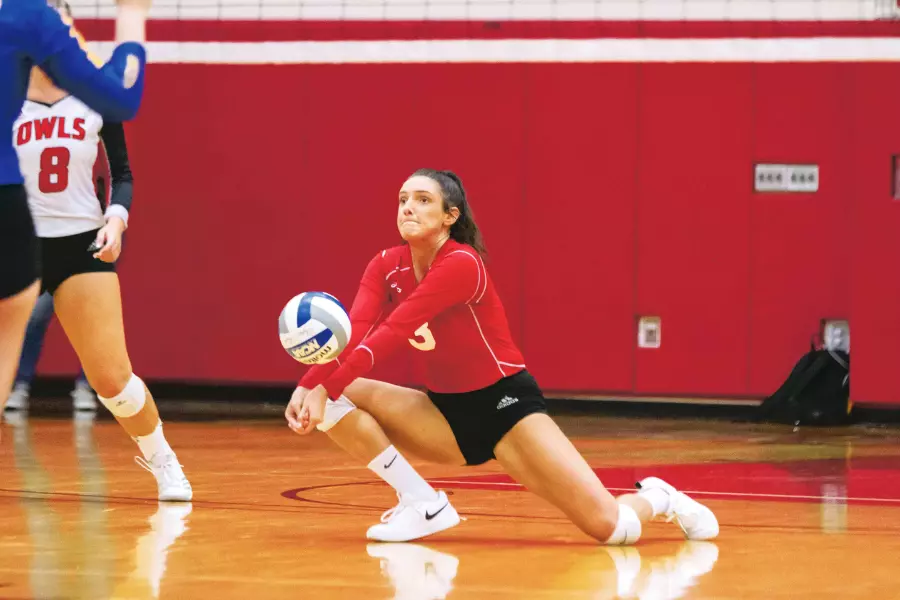Volleyball demands a combination of skills from its players due to its dynamic and fast-paced nature. We’ll explore the fundamentals of volleyball and explore what exactly a dig is in this article. The art of digging is a crucial skill that often stands out.
What Is A Dig In Volleyball?

What is a volleyball dig? In volleyball, a dig occurs after an opponent spikes or serves the ball toward a player’s side of the net.
What is the difference between a pass and a dig in volleyball?
There are some passes that are digs and others that are not digs in volleyball. A dig occurs after a ball has been served or spiked by an opponent.
Depending on the situation, volleyball digs may not be perfect passes to a teammate, since a dig is aimed at keeping the ball playable and continuing the rally, whereas passes are geared toward setting up a teammate for success.
What is considered a dig?
Digging in volleyball is only possible when a ball is passed as an attack attempt. It is an attempted attack on the passer’s team when the opponent spikes or serves the ball over the net. Passing the ball under the ball is considered a dig if a player can get under it.
A dig would not be considered, however, if the ball was touched by a player’s teammate prior to being passed. A regular pass would be used instead. In a similar vein, if an opposing player passes the ball but does not make a purposeful attack, that player will not make a dig.
In order to avoid violating the four-hit rule, an opponent might pass the ball gently over the net. Once the ball has been passed, the player could assist a setter or hitter by passing the ball so that a scoring opportunity can be created. Because it was not an attack attempt, this would be considered a pass rather than a dig.
What is the point of digging in volleyball?

In volleyball, digs are defensive plays that prevent the other team from scoring. The other team will score if a player cannot dig the ball after an attack or serve.
What is the benefit of getting a dig in volleyball?
Volleyball digs can set up scoring opportunities for a team when they are performed successfully. In addition to keeping the ball in play, digs allow the team to respond to an opponent’s attack by pressing forward.
Why is it important to dig in volleyball?
The defense of hard-driven balls is very challenging. It is possible to stop an opponent from scoring by digging. It is common for volleyball back-row players to specialize in this skill so as to help their team’s front-row players score.
Also, read How Many Sets Are in a Volleyball Game?
How to dig successfully in volleyball

Digging in volleyball can be improved in a number of ways. Starting with your ready stance and touching the ball when it’s time to dig, these techniques begin before the ball crosses the net.
Stay focused
Make sure you closely monitor your opponent before he or she serves or hits. They may be able to determine where the ball will go by the movements they make when attacking. Keep an eye on your team’s blockers before hitting. When the ball passes the protected areas, it can indicate which ones need to be covered.
Place yourself in a ready position
To complete a successful dig, volleyball players must take the right stance before attacking. In a ready position, your feet should be about twice the distance between your shoulders. Your knees should be bent as well. When you reach down, your fingertips should touch the floor when you bend forward at the waist.
Your weight should be on your toes, and your arms should be bent slightly out to the sides so you are ready to move at any moment.
Dig with the right technique
After an attack, the ball should be retrieved with a dig. Place your hips and shoulders to direct the ball in the desired direction. Your body should be behind the ball so you don’t throw it in a manner that’s difficult to retrieve for your teammates.
Try digging the ball with both arms if you can. Forearms should be joined together and extended in front of you to create a platform for the bump pass. Since you will be able to control the ball’s direction more easily, you will be able to send it to your target area more effectively.
For harder-driven balls, you should extend one forearm instead of both arms if they are moving too quickly or too far away from your body. Due to the greater probability of the ball shanking, achieving this successfully is much more difficult. One-armed digs can often be done by skilled diggers with practice, however.
Digging an attacked ball overhand is a less common method. When balls are traveling toward the front row at shoulder height or higher, players like blockers and outside hitters may use this technique to dig. To avoid a hard hit to their face or body, players can bounce the ball off their forearms or the heel of their hand according to the ball’s velocity.
You may enjoy reading Opposite Hitter Position In Volleyball
What Is An Overhand Dig?
A last-second overhand dig is a reaction to a high hard-driven ball. To keep their team in the game, the player strikes the ball with a firm overhand palm strike.
There will be times when you’ll be ready for a hard-driven ball heading toward the floor, only to be shocked when it suddenly jumps high. The hitter may have not snapped their wrist, resulting in a “line drive”. In some cases, the ball may ricochet off the block. You can also run into this problem if you cover too much forward on the court, and the hitter launches the ball deep.
It must be played extremely quickly if you think it will stay in bounds. Overhand digs are used here.
The ball is not being set, even though it looks like a set to beginners. Understanding this is essential or you can seriously injure your fingers. The ball is bounced toward your setter with strong, firm hands.
You should lean forward with your shoulders when you do this overhand dig. If the ball is hit, a palm-slapping sound should be heard.
You may enjoy reading Can You Touch the Net in Volleyball?
How to get a dig in volleyball?
In order to avoid shanking the ball, players stay low while popping the ball up. It would be ideal if they could pass the ball to a teammate to help set up a scoring opportunity.
As a result of a spike, players move their feet quickly or dive close to the ball’s trajectory and spread out one or both hands to retain control of the ball. Playability should be maintained if the task is completed successfully.
you may enjoy reading Best Setters In Volleyball
Who is the best digger on the team?
Generally, liberos are the best at digging in volleyball. With their lower center of gravity, liberos are able to retrieve difficult digs without losing their balance because they are usually the shortest players on their team.
Diggers may also be found in the back row of the defensive line. The most essential skill of a volleyball team is digging, regardless of position or talent.
How can you be a good volleyball digger?
In order to be a good volleyball player, you need the following skills:
Fast reaction time
A player’s chance of digging a ball successfully increases when he or she can respond quickly to an attack. Digging in volleyball often requires explosive movement, so players must react quickly.
Flexibility
Players must bend low to the ground when digging and move forward, backward, and laterally as necessary. It is important to have a full range of motion when digging.
Reading the game
By watching the way an opponent positions their body, players can better predict where the ball is headed. While serving or spiking the ball, it is also helpful to observe which areas of the court the opponent favors.
These skills can be developed effectively with digging drills for beginners. A digging drill often involves repetitions to help players develop the skills they need. Digging drills are a common component of warm-ups for many teams since digs are so crucial to defense.
You may enjoy reading What If Every Sport Was Photographed Like Beach Volleyball?
Volleyball passes: how are they rated?
Passes and digs in volleyball can be rated individually. An overall pass rating can be calculated by averaging a player’s grades. Based on a scale of zero to three, the value of a pass is determined as follows:
- Pass 0 = The opposing team scores a point when no pass is made.
- Pass 1 = Passing poorly or shanking that teammates can’t reach.
- Pass 2 = Muddled pass that limits the ball’s options for crossing the line.
- Pass 3 = A perfect pass that sets up the attack for the team.
When digging, players should aim for a three-rated pass.
How Dig is Used in Volleyball: Examples
The first is. A diving dig by Jenia Grebennikov keeps the game alive with the game on the line.
Faqs
How can I improve my digging skills in volleyball?
Get guidance from an experienced coach and practice regular drills with correct body positioning.
What is the libero’s role in digging?
Defense plays, including digs, are the libero’s specialty, and he is essential for maintaining a strong defensive front.
Are there specific drills for advanced digging techniques?
Players can master advanced digging techniques by practicing dive and roll drills, along with strategic positioning.
How has technology influenced digging strategies in volleyball?
With the advancement of technology, players can now analyze and improve their digging skills more effectively.
Can mental toughness be trained for better performance in critical moments?
In order to build mental toughness for consistent performance, it is important to practice mindfulness, visualize, and maintain a positive mindset.
Conclusion
To conclude, both players and enthusiasts of volleyball should understand what a dig is. Digs involve receiving and controlling an opponent’s attack without allowing the ball to reach the ground. Technique, agility, and quick reflexes are necessary aspects of successful volleyball play.
An effective counterattack depends on an effective dig, which not only contributes to a team’s defensive prowess but also sets the stage for a successful defense. It is important to recognize the significance of a dig in volleyball, whether you are a player aiming to improve your skills or a spectator seeking to gain a deeper understanding of the game.
Also, read Difference Between A Game And A Match In Volleyball





